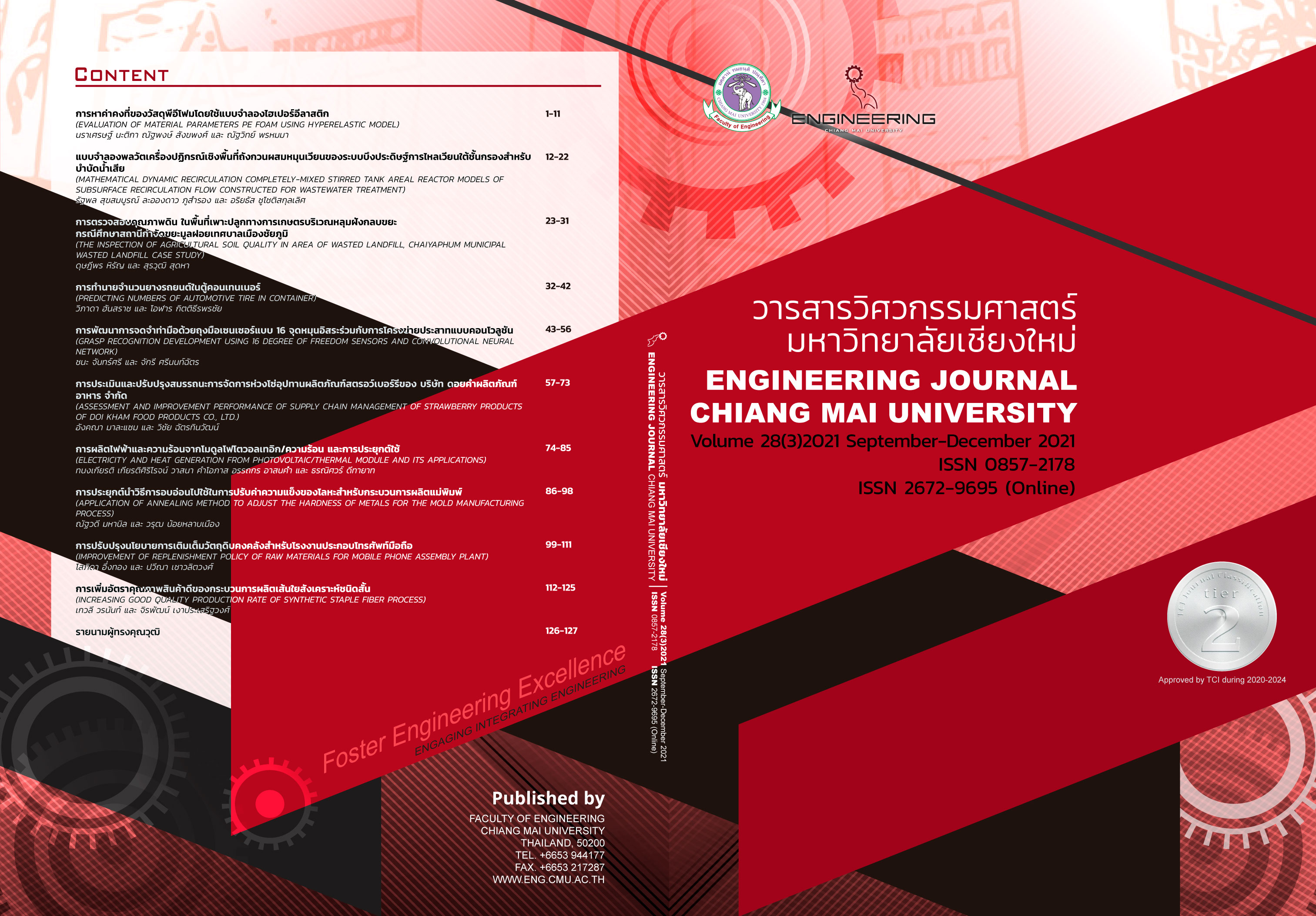Increasing Good Quality Production Rate of Synthetic Staple Fiber Process
Keywords:
Reduce waste, Failure Mode and Effect Analysis, Risk Priority Number, Synthetic Fiber, Good product quality rateAbstract
The objective of this research is to improve quality of synthetic staple fiber production rate by focusing on a decrease in the amount of non-quality products such as waste generating in the process. The included information from December 2019 to October 2020 and illustrated the frequency of problem using Pareto chart. The problem was, then, analyzed and justified into cause and effect diagram and evaluated through Failure Mode and Effect Analysis (FMEA) that consist of Severity, Occurrence and Detection which were utilized in calculating Risk Priority Number (RPN). This RPN was meant to prioritize problems according to their significance and identify the most affected problem to quality production rate. RPN score shows the factor that has the highest score are 1) Quench Air is uneven and 2) unrelated movement of Tow can and Roller.
The result of improvement has resulted in an increase in quality rate from 92.97 percent to 95.79 percent. Moreover, non-quality rate and waste was reduced from 7.03 percent to 4.21 percent. Thus, the profit was increased to 130,892.63 baht per month when producing 93 ton per day. From this investigation, the company in this case study started to increase production capacity to be 96 ton per day.
References
วราธร ปัญญางาม, “การจัดทำระบบการบำรุงรักษาเครื่องจักรด้วยเทคนิค FMEA กรณีศึกษา กระบวนการแปรรูปเนื้อสัตว์ตัวอย่าง,” วิศวสารลาดกระบัง., ปีที่ 33, ฉบับที่ 4, ธันวาคม, หน้า. 24-31, 2559.
รัฐกร อุดมสุข, “การปรับปรุงประสิทธิผลโดยรวมของเครื่องจักรในกระบวนการผลิตอิฐทนไฟ”, วิทยานิพนธ์ วศ.บ., จุฬาลงกรณ์มหาวิทยาลัย, กรุงเทพฯ, 2553.
อติศักดิ์ ไสวอมร, ระพีกาญจนะ, และกิตติพงษ์ กิมะพงศ์, “การวิเคราะห์ปัจจัยเสี่ยงของเครื่องเกี่ยวนวดข้าวโดยการประยุกต์โดยใช้เทคนิค Failure Mode and Effect Analysis (FMEA),” ในการประชุมวิชาการระดับชาติมหาวิทยาลัยเทคโนโลยีราชมงคลสุวรรณภูมิ ครั้งที่ 1, 2559, หน้า. 81-95.
J. Wu, J. Tian, and T. Zhao, “Failure mode prioritization by improved RPN calculation method,” in 2014 Reliability and Maintainability Symposium, 2014, pp. 1-6.
B. R. Krishnan, and K. A. Prasath, “Six Sigma concept and DMAIC implementation,” International Journal of Business, Management & Research (IJBMR)., vol. 3, pp. 111-114, Jun. 2013.
V. M. Magar, and V. B. Shinde, “Application of 7 quality control (7 QC) tools for continuous improvement of manufacturing processes,” International Journal of Engineering Research and General Science., vol. 2, no. 4, pp. 364-371, 2014.
M. Rogers, The definition and measurement of productivity. Victoria: The University of Melbourne, 1998.
รัชนีกร ด่านศิริชัยสวัสดิ์, การเพิ่มผลผลิต. อุดรธานี: สำนักพิมพ์แห่งมหาวิทยาลัยราชภัฏอุดรธานี, 2558.
ธนกฤษ ซุ่นเซ่ง, “การลดของเสียในกระบวนการฉีดพลาสติก กรณีศึกษา : ของเสียประเภทจุดสีดำ,”, วิทยานิพนธ์ วศ.บ., มหาวิทยาลัยธุรกิจบัณฑิตย์, กรุงเทพฯ, 2557.
ศุภวัชร์ เมฆบูรณ์ และ จีรวัฒน์ ปล้องใหม่, “การลดของเสียในกระบวนการผลิตโพลิเมอร์โซลิค คาปาซิเตอร์,” วิศวกรรมสารเกษมบัณฑิต, ปีที่ 7, ฉบับที่ 1, หน้า 105-123, 2560.
ยุทธณรงค์ จงจันทร์, “การลดของเสียในการนึ่งยางรถยนต์,” วารสารวิชาการมหาวิทยาลัยธนบุรี, ปีที่ 8, ฉบับที่ 15, หน้า 49-57, 2557.
วรรณภา สาระดำ, “การลดของเสียในกระบวนการผลิตแผ่นวงจรไฟฟ้าแบบยืดหยุ่นได้ โดยเทคนิคซิกซ์ซิกม่า”,วิทยานิพนธ์ วศ.บ., มหาวิทยาลัยธรรมศาสตร์, ปทุมธานี, 2558.
D. C. Montgomery, Introduction to Statistical Quality Control. 6th edition, USA: John Wiley & Sons, 2009.
นายฐรรศ สีหะนันท์, “การใช้เทคนิคไคเซนช่วยเพิ่มประสิทธิภาพการปฏิบัติงาน ในส่วนงานกองช่าง องค์การบริหารส่วนตำบลไพบูลย์ อำเภอน้ำขุ่น”, วิทยานิพนธ์ วศ.บ., มหาวิทยาลัยเทคโนโลยีสุรนารี, อุบลราชธานี, 2560.
อาภาพร จันทะมาศ, “การเพิ่มผลิตภาพในกระบวนการทำให้แห้งแบบพ่นฝอยในการผลิตสีย้อมผ้า”, วิทยานิพนธ์ วศ.บ., จุฬาลงกรณ์มหาวิทยาลัย, กรุงเทพฯ, 2554.
Downloads
Published
Issue
Section
License
ลิขสิทธิ์ของบทความที่ตีพิมพ์ในวารสารฉบับนี้จะยังเป็นของผู้แต่งและยินยอมให้สิทธิ์เผยแพร่กับทางวารสาร
การเผยแพร่ในระบบวารสารแบบเปิดนี้ บทความจะสามารถนำไปใช้ได้ฟรีในการศึกษา และในทางที่ไม่เกี่ยวกับการค้า




